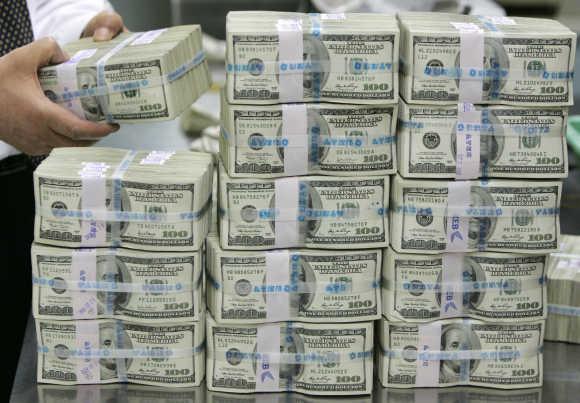 | « Back to article | Print this article |
 Indian exports, which was hit by global slowdown last year, are likely to remain sluggish during 2013 as well due to challenging economic conditions in western economies, though policymakers have drawn a strategy to diversify exports.
Indian exports, which was hit by global slowdown last year, are likely to remain sluggish during 2013 as well due to challenging economic conditions in western economies, though policymakers have drawn a strategy to diversify exports.
The year started on a double-digit growth for exports, but gradually declined and finally entered the negative territory in May.
In January 2012, outbound shipments grew by 10 per cent before contracting by about 5 per cent in May, with no major turnaround since then.
The government's effort to diversify from the traditional markets of the US and Europe yielded positive results but dependence on the western economies have led to decline in the country's overall merchandise shipments. These two market accounts for about one-third of India's exports.
Although India's exports surpassed the $300-billion mark and reached $307 billion during 2011-12, the country's trade deficit also touched an all-time high of $185 billion in the period.
During January-November 2012, the trade gap has widened to $175.5 billion compared to $146.9 in the comparable period last year.
For government, it is a major cause of concern, as widening trade gap directly impacts current account deficit (CAD) and domestic currency. CAD stood at 3.9 per cent of GDP in the April-June quarter.
Due to the global demand slowdown, India's exports during the current fiscal are likely to barely cross $300 billion against the ambitious target of $360 billion for the current fiscal.
According to the Commerce Secretary S R Rao, any ripple worldwide will impact India's commerce as the country's integration with the global trade has reached a high level.
Slowing global output growth has led to World Trade Organisation (WTO) cut its 2012 forecast for world trade expansion to 2.5 per cent from 3.7 per cent and to scale back the 2013 growth estimate to 4.5 per cent from 5.6 per cent.
"In an increasingly interdependent world, economic shocks in one region can quickly spread to others," WTO Director General Pascal Lamy has said.
Federation of Indian Export Organisations (FIEO) has said the year 2012 had been difficult for exporters.
"Domestic issues like poor infrastructure, increasing transactions cost and some procedural hurdles are huge challenges for exporters," FIEO President Rafeeq Ahmed said.
Sharing similar views, Rakesh Mohan Joshi, internal trade expert and Professor with India's prestigious Indian Institute of Foreign Trade (IIFT) said the ballooning trade deficit poses serious challenges to the government.
"2012 was not a good year for India's exports. Trade deficit touched an all-time high. It is matter of serious concern for the government and I do not even see 2013 as a better for them (exports). Situation may improve, but marginally," Joshi said.
He said the condition in Europe is not satisfactory and there are no signs of improvement. "Along with global issues, domestic conditions are also not good. There is a strong need to boost investments in the manufacturing sector," he added.
Apparel Export Promotion Council (AEPC) Chairman A Sakthivel too said 2012 was one of the most challenging years. "We witnessed lower buyer sentiments due to sluggish market condition," he said.
Sectors which contribute maximum in the country's exports have been registering negative growth since April-November period of this fiscal.
While exports of engineering and gems and jewellery items contracted by 5.3 per cent and 10 per cent, respectively, that of cotton yarn, jute, readymade garments and handicrafts shrunk by 11 per cent, 14 per cent, 8 per cent and 65 per cent, respectively, during April-November period of the current fiscal.
"This is a matter of serious concern to us. They are directly linked to job creation and job sustenance," Commerce and Industry Minister Anand Sharma has said.
However, the government is making every effort to support exporters. Sharma has recently announced several measures including extension of cheap loan facility for one more year till March 2014. The minister said those incentives will help in bridging the trade deficit.
The two per cent interest subsidy scheme, which was to end on March 2013 has been extended for one more year. Besides, more sectors have been covered under it with the engineering exporters being the major beneficiaries.
Merchandise shipments to the US, European Union and the Asian markets will now qualify for additional sops. Exporters are facing a demand slowdown in these markets.
"With these measures, we should be able to give a push to our exports in the last quarter of this financial year. The objective is to stabilise the situation and try and move from the negative territory to positive," Sharma has said.
Rising trade deficit has been cited by several global rating agencies like S&P as a key area of concern for the Indian economy.
Ta-Ta, Ratan: An iconic Indian